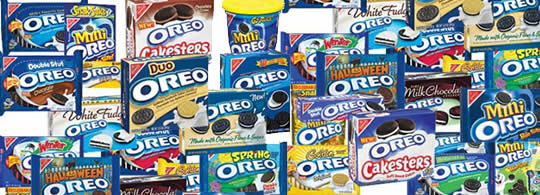Mega-Branding: The Purple Oreo Problem

In Decoy Marketing, I described my befuddlement when staring at a shelf full of shaving gel product variations. In that case, a jumbo-sized can at the same price as the regular-sized cans put an end to my indecision. It turns out I’m not the only marketer with an eye on the shaving gel shelf. In The Pitfalls of Megabranding – Consumers Don’t Necessarily Want More Choice, Ad Age’s Al Ries notes, “Edge shaving gel now comes in 13 different varieties, some of which have exceedingly long names like Edge Active Care Shave Gel Natural Cool, with Eucalyptus.”
A key conclusion of Ries’s post is that the proliferation of brand variants is leaving less shelf space for the best-selling original product, in turn leading to stockouts and lower sales, not to mention dilution of the original brand. Here’s a quick scorecard on how popular brands are exploding:
Tostitos – 11 varieties
Wheat Thins – 11
Gatorade – 23
Goldfish – 16
Does the market really need 16 flavors of Goldfish crackers, including “Blazin’ Buffalo Wing Flavor Blasted Goldfish?”
46 Kinds of Oreos – Including Purple
Ries didn’t include my favorite example of branding excess in his post: Oreo cookies. The Nabisco website lists 46 varieties of Oreo products, almost all sandwich cookies with different stuff in the middle or different cookie-halves to contain the stuff in the middle. Some of these products may well be sensible: Double Stuf (with twice the frosting) is no doubt a popular variant. Some of the more unusual ones include “Chocolate Sandwich with Organic Sugar and Flour” and, of course, “Spring Purple Creme.” For those who can’t decide if they like chocolate or vanilla better, a “Duo” variety uses one of each cookie to form the sandwich. (Unfortunately, it doesn’t look like they have introduced that one with the optional purple frosting yet.) There’s also the cryptically-named “Golden Uh-Oh with Chocolate Creme.”
Mega-branding’s Mega-Problem
In addition to the inventory issues and potential loss of brand focus that Ries highlights, I’d add one other problem: behavioral research shows that too many choices reduce sales. In More Choices, Fewer Sales, I described research which showed that consumers presented with a large number of choices made only a tenth as many purchases than those with just a few:
A 2000 study at Columbia University compared consumer behavior when confronted with a selection of either six or 24 gourmet jams in an upscale grocery store. The bigger selection did indeed cause more customers to stop and check it out – 60% vs. 40% for the limited selection. The interesting part, though, was the purchasing behavior. While 30% of the customers presented with the limited selection made a purchase, a mere 3% of those who saw the extensive selection bought something.
How different is the research setting – a couple of dozen gourmet jams – from 16 varieties of Goldfish? Or a shelf unit full from top to bottom with different Oreo variations? I think it’s very possible that even as these mega-brands garner more shelf space, they could be selling less total product than had they focused their efforts on a few key varieties.
To top it off, despite their 46 varieties, Nabisco still hasn’t introduced the Oreo variation I’d find most appealing: pre-opened Oreos, minus the cookie half that the creamy filling didn’t stick to. 😉
